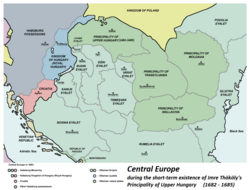The Principality of Upper Hungary[1] (Hungarian: Felső-Magyarországi Fejedelemség; Ottoman Turkish: او رتا ماجار, romanized: Orta Macâr, lit. 'Middle Hungary') was a short-lived Ottoman vassal state ruled by Imre Thököly.
Principality of Upper Hungary Felső-Magyarországi Fejedelemség Orta Macar | |||||||||
|---|---|---|---|---|---|---|---|---|---|
| 1682–1685 | |||||||||
|
Banner | |||||||||
 Principality of Upper Hungary in 1683 | |||||||||
| Status | Vassal state of the Ottoman Empire | ||||||||
| Capital | Kassa (present-day Košice) | ||||||||
| Government | Principality | ||||||||
| Prince | |||||||||
• 1682-1685 | Emeric Thököly | ||||||||
| History | |||||||||
• Established | November 19, 1682 | ||||||||
• Disestablished | October 15, 1685 | ||||||||
| ISO 3166 code | HU | ||||||||
| |||||||||
| Today part of | Hungary, Romania, Slovakia | ||||||||
Background edit
After peace treaty of Vasvár was signed in 1664, loyalty felt by Hungarians towards the Habsburg dynasty was in decline. The Hungarian nobility was dissatisfied by Emperor Leopold I's refusal to capitalize on the victory at the Battle of Saint Gotthard to liberate more of the Hungarian lands from the Ottomans, and the subsequent Imperial administration of Hungary was seen as acting against interests of the Hungarian estates. In 1671 a rebellion was successfully thwarted. However, a year later Mihály Teleki led a more successful rebellion. In 1673 the Emperor appointed Johann Caspar von Ampringen, the Teutonic Grandmaster as governor of Royal Hungary, precipitating a harsh crackdown on disloyal nobles and Protestants which further increased the resentment of the Hungarian nobility against the Habsburgs. In 1680 Imre Thököly became the leading figure of the rebellion, which started being supported and sustained by the Ottoman state and the Principality of Transylvania.[2][3]
Establishment and later history edit
The principality was established on 19 November 1682.[4] The polity agreed to pay 20,000 gold coins to the Ottomans annually.[5] In 1685 Thököly was defeated at Eperjes (present-day Prešov) and the Turks imprisoned him because of his previous negotiations with Leopold therefore his realm ceased to exist.
See also edit
References edit
- ^ Hadtörténelmi közlemények, Volume 118, Issues 3-4, Hadtörténeti Intézet és Múzeum, 2005, p. 409
- ^ Balázs Trencsényi; Márton Zászkaliczky (2010). Whose Love of Which Country?: Composite States, National Histories and Patriotic Discourses in Early Modern East Central Europe. BRILL. p. 547. ISBN 978-90-04-18262-2.
- ^ István Keul (2009). Early Modern Religious Communities in East-Central Europe: Ethnic Diversity, Denominational Plurality, and Corporative Politics in the Principality of Transylvania (1526-1691). BRILL. p. 219. ISBN 978-90-04-17652-2.
- ^ J. János Varga, A fogyó félhold árnyékában, Gondolat, Budapest, 1986, p. 31
- ^ "Kereszt és félhold". mek.oszk.hu.
